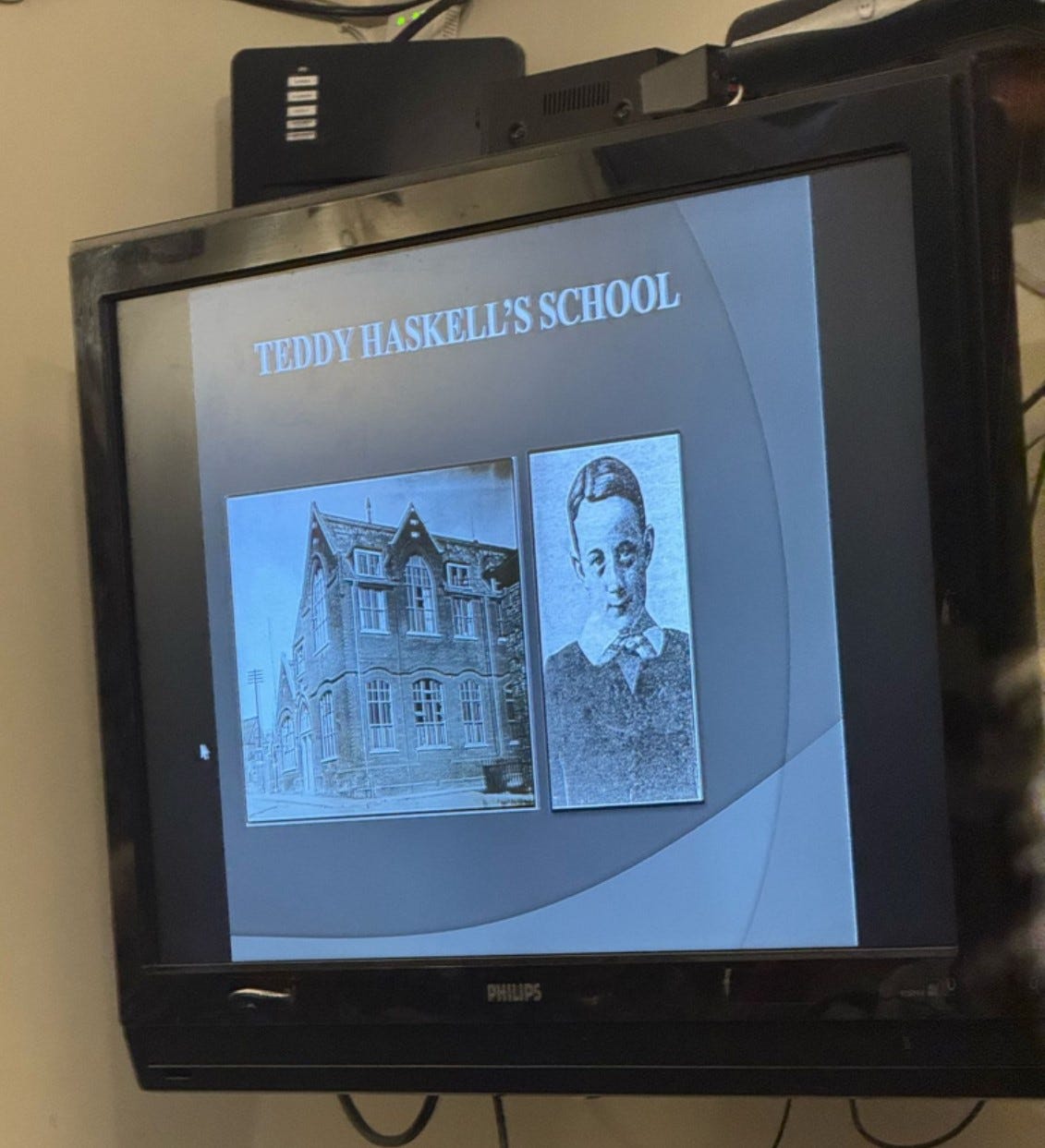Inside Salisbury: Fisherton History Society Review: The murder of Teddy Haskell
The Fisherton History Society brought to life the unsolved murder of a young Salisbury boy
by Maggie Burns
Last night, the Duke of York pub hosted the Fisherton History Society’s 10th anniversary talk. Fittingly, Frogg Moody had decided to revisit the very first talk he’d made to the society about the murder of young Teddy Haskell, who lived in 40 Meadow Road – just across from the Duke of York.
With guest input from the society’s wonderful team of speakers - Matt Pike, George Fleming and Ruby Vitorino-Moody, it was both riveting and entertaining, as always. Being put on the spot by Frogg, all three gave a terrific performance showing just how passionate they are about the subject.
The venue was very well attended.
By 7.25pm it was already standing room only. Paul Cooper was the chef in the courtyard providing delicious burgers and hotdogs. We won’t mention Frogg’s ketchup mishap other than to say it was a good visual demonstration of Flora Haskell’s blood-splattered apron!
Frogg gave an overview of the, to this day unsolved, poignant murder of a popular local child. Edwin (Teddy) Haskell was just 12 years old when he was killed in his bed on Halloween night in 1908. His throat had been cut and his savings stolen.
Read more: Remodelling work at Salisbury Railway Station enters third phase
Although, having endured two trials, his mother was found not guilty of his murder due to lack of evidence, many people were convinced she had killed her son. Any motive she could have had is unclear. It was well known that she, a widow, adored Teddy, an only child and a cripple having lost a leg from tuberculosis (TB). Witnesses confirmed that the boy was very well cared for, happy, clean and loved and yet, the formal death certificate specified death, ‘cut throat by mother’!
George Fleming explained how Sgt Golding & Chief Constable Richardson of Salisbury’s police removed essential forensic evidence. Golding allowed the hallway floor to be washed - scrubbed clean by Flora’s mother, removing the evidence of the blood splatters that may have aided Flora’s case or perhaps proved her guilt.
In his defence, Golding repeatedly confirmed his only instruction was to ensure nobody went upstairs. He also collected the murder weapon, placing the bloody knife in his pocket. He reported to Richardson, who asked him to keep it over the weekend, so by the Monday any useful forensic evidence was lost. Also, Teddy’s body was repositioned on the bed, and the blood-covered bedding was removed and replaced. Whilst this would have made it less horrific for people to see, it completely contaminated the crime scene.
The investigation was handed over to Scotland Yard, and Chief Inspector Dew (who arrested Crippen) took on the case. However, he had made his mind up about Flora even before any evidence was considered.
Frogg Moody obtained, from descendants of Chief Constable Richardson, some previously unseen photographs of the house taken during the 1908 investigation. These provided us with a wonderful insight of life in the local area 117 years ago. One photograph, taken in 2008, shows George Fleming coming down the stairs and the then resident of the house standing in the doorway – visually demonstrating Flora’s account that she came through the door from the kitchen and saw a man running down the stairs who threw the bloody knife at her, splattering her apron.
Matt Pike described the area for us. He discussed photographs showing how York Road and Meadow Road looked at the time and gave an entertaining discussion of landowner Thomas Scammell who built many of the houses around these streets. Indeed, Scammell owned the land the Duke of York was later built on.
Read more: Former political prisoner to give free talk at Salisbury Cathedral
Towards the end of the talk, after discussing the court cases and the ultimate inability to find Flora or anyone else guilty, Ruby Vitorino Moody briefly spoke about a local man, John Ray, who disappeared from the area at that time. Despite this being the very same night, around the same time, and the man living around the corner from Meadow Road, the two cases were never considered in tandem.
Two of Ray’s children were classmates of Teddy at school, so he is likely to have spoken to them about the money he’d saved to purchase a new prosthetic leg. We speculated that the children may have talked about this to their father, who Ruby described as ‘a not very nice man’, and possibly, the opportunity to rob the child was taken. As he was likely to recognise the man, this could be why Teddy was killed, in his sleep, to avoid detection. Ruby’s research into both cases has thrown good suspicion on Ray, but of course, we can’t categorically determine any guilt, or otherwise. Ruby has previously given an in-depth talk on Ray, and we hope she’ll do so again for those who did not attend.
The Teddy Haskell case is Salisbury’s ‘Ripper’ and we have researched and reviewed evidence, and considered various scenarios, but we are not likely to ever completely determine who the culprit was. But you just can’t help but try.
Teddy is buried in Devizes Road cemetery, although his gravestone is difficult to read now. I regularly pop along and visit. Frogg co-wrote a book about the case, with Bruce Purvis, ‘If I Did It, I Don’t Remember’ which is still available to buy.








